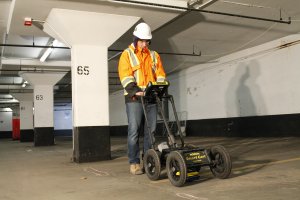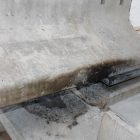Non-destrcutive Testing- NDT Methods for Evaluation of Parking Garages can help improve the quality of routine inspection and maintenance. Parking garages require routine inspection and maintenance to ensure they remain safe and operational. Weather it is a public parking in extremely busy downtown areas, or a private condominium structure, proper maintenance is needed to keep them safe. The importance of parking garages is often ignored, simply because nobody lives in them; while these facilities are often exposed to harsh condition, they are under-maintained and over-used (John M. Porter, PE, and Nathan D. Boutin, PE).
Deterioration of Parking Garages
Several deterioration mechanisms can affect the performance of a parking garage. Even when they are indoor, moving vehicles may help expose garage floors to aggressive agents. In general, parking garages are exposed to de-icing salts (or other chemical) which can cause corrosion; freeze and thaw cycles, and moisture (Read more). cyclic loads from the movement of vehicles can also aggravate the condition of concrete slabs. These deterioration mechanism can affect the safety and reliability of the structure. Porter and Cohen believe that “it is critical to identify the cause of the damage to identify repair alternatives and estimate repair costs” (Porter and Cohen).
Maintenance of Parking Garages
Every parking garage structure needs a comprehensive maintenance plan. This is necessary to protect the owner’s investment, regardless of age and type of construction. Most life-cycle problems can be prevented or reasonably managed through proper design, construction and maintenance (Porter and Cohen). Porter and Boutin believe that when parking structures are not maintained properly, (i.e. condition assessments are not performed on a regular basis), the cost of repair costs can grow exponentially.
Inspection of Parking Garages

Similar to most condition assessment projects, the first in the line is visual inspection of structural and non-structural components. Visual inspection is used to record the location and extent of deterioration, distress, and leakage.
Acoustic sound test (chain dragging) followed by the visual inspection can be used to narrow down the inspection area. Acoustic testing can reveal the locations and extent of delamination and/or scaling.
NDT Methods for Evaluation of Parking Garages
Non-destructive testing can be beneficial when dealing with large parking areas. NDT methods can show a precise map of deficiencies on the concrete slab. Different NDT methods can be used for different applications. The following describes the list of NDT methods that can be used in a condition assessment project:

1- Corrosion Mapping (Half-Cell Potential): Corrosion mapping is a widely used test procedure to identify the areas with active corrosion activity. The test can reveal the locations with high likelihood of corrosion; it can also be used to evaluate the quality of repair. Learn more: Corrosion Survey of RC Structures
2- Surface Electrical Resistivity: Electrical Resistivity of concrete can provide useful information about the resistance of concrete material to penetration of chloride ion. This method is adapted by several Department of Transportation (DOTs) to replace the labour-intensive and time-consuming Rapid Chloride Permeability Test (RCPT).

3- Ultrasonic Testing (Ultrasonic Pulse Velocity/Echo): Acoustic methods can be used to locate and quantify delaminated area on the concrete slab. Acoustic method have successfully been used for evaluation of concrete deck slab in bridge structures. They can be used to detect voids in walls, or slabs, as well as predicting the thickness. Learn more: Ultrasonic Survey for RC Decks
4- Ground Penetrating Radar – GPR: This method can be used to determine the concrete cover over reinforcement. The test can be used to locate delaminated area, and area with excessive moisture. Learn more: Corrosion Mapping using GPR







